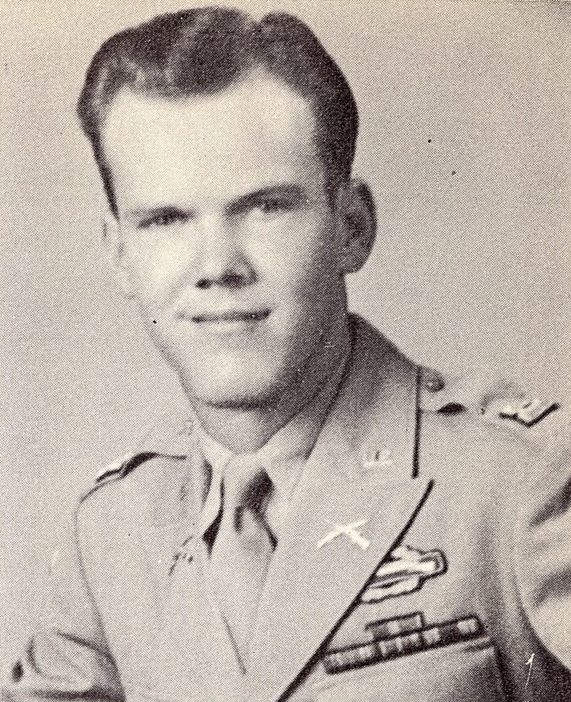Captain JOHN H. ATTERBURY, JR.

Captain JOHN H. ATTERBURY, JR. US Army Infantry. He lived at Box 916, Baytown, Texas. He was born in 1923 in Knox City, Texas but his family lived in nearby Benjamin, Texas. He attended and graduated from Knox City High in 1941 and entered Texas A&M that fall. “I remember sitting at my desk over my drawing board in Mitchell Hall when I heard the news of Pearl Harbor. I remember thinking that this would have an effect on the rest of my life. And it did.” His class signed ROTC contracts and became enlisted reserves in December 1942. On March 23, 1943, his class was called to active duty but they allowed us to return to school to finish the semester. He was sent to Camp Roberts in California for infantry basic and then back to A&M under the ASTP program to re-enter school and await an OCS opening. Atterbury was sent to Fort Benning, Georgia for infantry OCS (officer candidate school) and was awarded his commission as a 2nd Lieutenant in June 1944. After commissioning he and Josie were married at the Chapel in the Woods on the campus of what is now TWU Texas Women’s University. He was assigned as a rifle platoon leader to Company A, 5th Infantry Regiment, 71st Infantry Division. “One of the Lieutenants in Company B was a southern boy from Mississippi and he got into an argument with his men, who were mostly from the Northeast, over the Civil War. He was reassigned and I took over his platoon in Company B. Those men would become like part of my family.” He went overseas to the European Theatre on January 26, 1945. “We were sent to relieve the 100th Division of the 7th Army near Bitche, France, which was near the Italian border. The first contact and action our Division had with the Germans, was by my platoon. My platoon was selected to seize a German emplacement 600 yards in front of our lines — at night. I and all of my men had never been in combat before. To say we were a little nervous is an understatement.”
“The first thing we ran into was a dead soldier from the 100th Division that was hung up in the wire. That didn’t help our nerves. We were fortunate that the Germans decided, after some resistance, to leave the area. That is how my platoon earned our combat infantryman’s badge.” Atterbury and his platoon received a commendation from the commanding officer of the battalion for their action that night.
“Some of the other companies lost a lot of men in the minefields but we were fortunate. After we took the knoll and dug in, the next day we discovered that we had been left by the rest of our company and battalion. Finding ourselves all alone was about as unsettling as our first mission the night before.” “After this we were assigned to Patton’s Army and headed over the Siegfried Line into Germany and on to Austria. We had the Germans on the run and had mostly skirmishes. We crossed the Danube and at a small town named Augburg, Germany, we ran into German troops that were dug in. They had mortars located in the neighboring town and most of the casualties came from the mortars. We had captured eight Germans and had them in the street in a group when one of their mortars hit in the middle of them. It killed all of them.” Atterbury and his platoon led the attack on Augberg. For his personal actions, Atterbury was awarded the Bronze Star and promoted to 1st Lieutenant. “We halted at the Steyr River in Austria. An SS officer came across the river and volunteered his men to join with us to fight the Russians. We declined his offer. Over 50,000 Germans and Hungarians came across the river and surrendered to us to avoid the Russians.” The war ended on May 8, 1945 in Europe, and Atterbury and his men began to train for Japan. “Before we were to leave for Japan, General Patton reviewed the troops and said his goodbyes to his army.” He returned to United States on June 6, 1946, he was discharged on July 15, 1946 at Fort Sam Houston, Texas after he had served 40 months in the US Army. He was awarded the Bronze Star Medal, the Combat Infantryman’s Badge. the European Theatre Medal for Central Germany, and the Rhineland. He returned to Texas A&M and got his degree in mechanical engineering in May 1947. He went to work as an Engineer for Humble Oil and Refining Company. He returned to A&M to get his masters degree. He stayed with Humble, and later Exxon, until he retired in 1986. He moved back to College Station and has have been attending Aggie games ever since.
2- https://theeagle.com/veterans/john-atterbury-wwii-veteran/article_7be475ae-7933-11e6-9db8-67058de88cd7.html